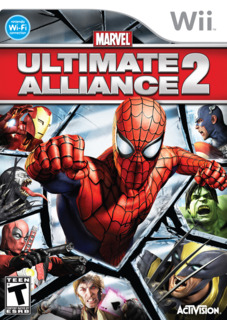The Battle Comes Home
The game picks up where the other game ended in Latveria, in Doomstadt, though with the demise of Doom for attempting to steal Odin's powers in MUA, someone else is now in charge. A woman named Lucia Von Bardas. Fury's threat evaluation of Latveria claims Von Bardas is indirectly funding upgrades to supervillains world wide.
This evaluation is not taken seriously and the government dismisses it. Fury attempts an unsanctioned covert operation into Castle Doom to eliminate Von Bardas. She appears to perish except a year later a resurrected/cybernetic Von Bardas leads a terrorist attack against America with the assistance of her fellow Latverians.
Fury goes underground after the recovery efforts leaving the heroes to face the growing sentiment to push for a Superhuman Registration Act. At first everything is united, however the 600+ dead as result of the explosion in Stamford pushes the act forward. Divisions begin to form with Captain America becoming the leader of the Anti-Reg movement while Iron Man leads the Pro-Reg faction.
Once down with the Anti-Reg, I intend to go back and play the Pro side.
The game from that point forward unfolds depending on who you side with. So far I have only finished the Anti-Reg side, but eventually it becomes clear something else is at work, had been at work since before SHA was passed. This third faction draws the two camps back together to fight this threat calling itself the Fold.
The divergent storyline from a single choice is a different plot advancement then the optional objectives leading to different results based on action or inaction in MUA.
The Kobayashi Maru of MUA was having to decide between saving Jean or Kurt in Mephisto's Realm. Both have dire consequences. Whereas the rest are either positive or negative because of action/inaction.
However game play at times feels uneven. Fusion attacks are not always successful until you know what certain fusions will do. At times the game will lag when you are fighting multiple enemies and frequently one/two/three... and sometimes all heroes will die.
When that happened I had recall of the final battle from XML where its the X-Men versus the rebuilt Master mold. The only plus since XML is that character revival is cost free in MUA and takes only one fusion star to revive a character in this game.
Visually the game environments at times are also a step back even from the environments of XML or XML 2. MUA's environments were generally very attractive or artistically done.
As for Stark Tower it looks virtually the same except not quite as defined in certain ways as it was in Act 1 of MUA.
The Acts by far are shorter if you are playing nonstop. The pick up bonuses are fewer and you don't have to look for comic book mission type discs as they have been replaced almost entirely by recruitment missions. So in order to unlock undecided characters you do recruitment missions, both for heroes and villains.
The auto save function also creates a lag between areas and the load times are definitely longer, but that is manageable.
The comic book back story was mostly a mystery to me as I haven't read Secret War or Civil War aside from summaries I read in order to get some grasp on the storyline they were following.
Some familiar pitfalls and some changes yet overall it doesn't pass the visual opulence of MUA, but on its own MUA 2 Fusion is enjoyable. I'll admit it could have been better, but I have seen comic book inspired games done worse than this.

